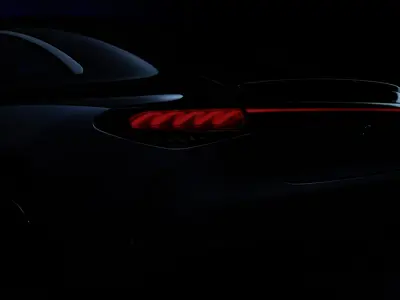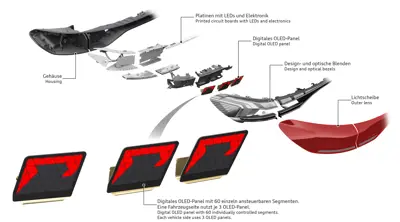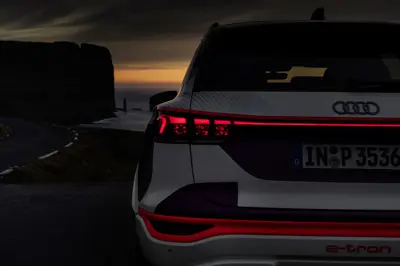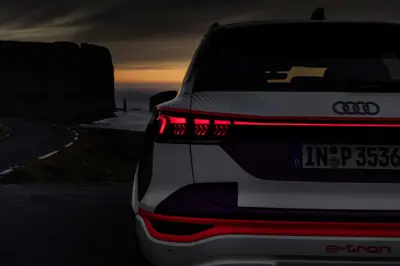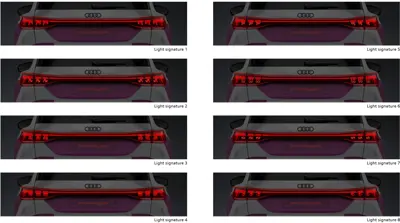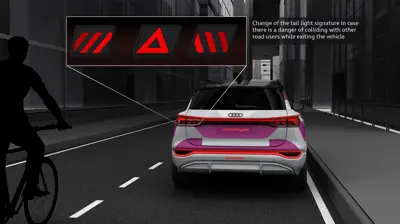Rear lights
Rear lights are crucial for vehicle safety, ensuring that motorists can see and be seen on the road.
Rear lights, also known as tail lights, are essential components of a car's lighting system. They have undergone significant technological advancements and design innovations over the years.
From their humble beginnings as simple incandescent bulbs to today's cutting-edge LED lights, rear lights have come a long way in functionality and aesthetics.
LED Revolution: Efficiency, Versatility, and Style
The introduction of Light Emitting Diode (LED) technology in the automotive industry marked a significant milestone in the evolution of rear lights. LEDs are small, solid-state devices that emit light when an electric current passes through a semiconductor material, eliminating the need for a filament or gas to produce light. These features make LEDs more energy-efficient, durable, and versatile than traditional incandescent bulbs, leading to widespread adoption in modern automotive lighting systems.
One of the key advantages of LED rear lights is their efficiency. LEDs require significantly less energy to produce the same light as incandescent bulbs, reducing power consumption and improving electric range.
Furthermore, LEDs are known for their durability. They have a longer lifespan than incandescent bulbs, as they are not prone to burning out or breaking easily. This feature means that vehicle owners can enjoy longer-lasting rear lights that require fewer replacements, reducing maintenance costs.
In terms of versatility, LEDs offer automotive designers greater flexibility in creating unique and innovative rear light designs. LEDs are available in various shapes, sizes, and colors, allowing for creative freedom in designing rear lights that are not only functional but also visually appealing. These features have resulted in a wide range of rear light designs, from sleek and minimalist to bold and futuristic, adding a touch of style to modern vehicles.
OLED
Some manufacturers have started using OLED rear lights. OLED lights are thin light sources made of organic semiconductor materials. OLED stands for Organic Light Emitting Diode. Manufacturers use OLED light technology for automotive applications because of its homogeneous light emission and ultra-thin, lightweight form factor. OLED lights can also be flexible, transparent, and color-tunable.
Flexible OLED lights can seamlessly integrate into curved surfaces, allowing for even more creative and futuristic rear light designs.
The Audi Q6 e-tron is one example of an EV using OLED rear lights. The illustration below shows how Audi has integrated OLED panels in the Audi Q6 e-tron rear lights.
Advanced Features: Safety and Convenience
With the advent of LED technology, rear lights have evolved beyond their traditional role of simply emitting light to indicate the presence of a vehicle. Advanced features have been incorporated into rear lights to enhance safety and convenience for drivers and other road users.
One such feature is dynamic or animated rear lights, also known as sequential turn signals. These rear lights use a series of LEDs that light up sequentially to indicate the direction in which the vehicle is turning. For example, when the driver activates the right turn signal, the LEDs on the right side of the rear light assembly light up sequentially from the inside to the outside, creating a dynamic and eye-catching effect that is more noticeable to other drivers. This sequential turn signal enhances the visibility of the vehicle's intended direction and adds a modern and futuristic look to the rear lights.
Another advanced feature is the use of adaptive rear lighting. This technology adjusts the intensity and direction of the rear lights based on various factors such as the vehicle’s speed, weather conditions, and road curvature. For example, during low visibility conditions such as fog or heavy rain, the adaptive rear lights may increase the intensity to improve visibility for other drivers behind the vehicle. Similarly, during high-speed driving or when navigating a curved road, the adaptive rear lights may adjust their direction to provide better illumination around the bend, improving safety and reducing the risk of accidents.
Furthermore, some manufacturers have integrated rear lights with other safety features, such as collision detection and warning systems. These systems use sensors and cameras to detect potential collisions from the rear. The car can use the rear lights to quickly alert the driver with increased intensity or flashing patterns, warning them of a possible rear-end collision. This additional safety layer helps prevent accidents and protect the vehicle's occupants.
Design Innovation: Beyond Functionality
In addition to their technological advancements, rear lights have undergone significant design innovations. Automotive designers are increasingly using rear lights as a design element to create a distinct and recognizable look for their vehicles. Rear lights are now considered integral to a vehicle's overall aesthetic appeal and have become a canvas for creative expression.
One popular trend in rear light design is using three-dimensional (3D) graphics and shapes. With LEDs, automotive designers can create intricate patterns and shapes that add depth and dimension to the rear lights. This design creates a striking visual effect, making the rear lights stand out and giving the vehicle a modern and futuristic look.
In addition, some manufacturers offer the owner the ability to set their light signature. An example is the Audi Q6 e-tron, where you can select eight signatures for the rear lights.
Another design innovation is using smoked or tinted lenses for rear lights. Smoked or tinted lenses have a darker or blacked-out appearance, giving the rear lights a sleek and stealthy look. This design trend has gained popularity in recent years, especially in the luxury and performance vehicle segments, as it adds a touch of sophistication and exclusivity to the vehicle's rear end.
Furthermore, manufacturers integrate rear lights into other parts of the vehicle’s body, such as the rear bumper, diffuser, or body panels. This seamless integration of rear lights into the vehicle’s overall design creates a cohesive and harmonious look, enhancing its aesthetic appeal and making it visually distinct on the road.
Communication Lighting
Some manufacturers have started using rear lights to communicate with others, where the rear lights can send signals or messages to other vehicles or pedestrians.
For example, the Audi Q6 e-tron has added an extra dimension to the exit warning function. Previously, it only informed the occupants when exiting the car, for example, if another vehicle or a bicycle was approaching. But now, a specially adapted light signature in the rear light graphic warns cyclists or drivers approaching from behind. In this way, the Audi Q6 e-tron extends its safety concept to other road users, increasing road safety for everyone.
Examples
Below is a video from Audi that shows how their OLED technology works.

